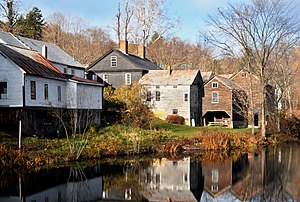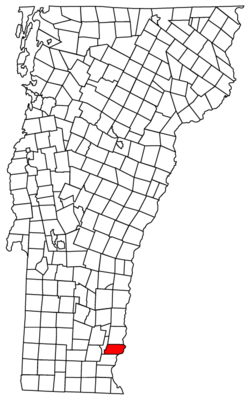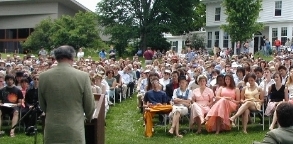Putney, Vermont
Town in Vermont, United States From Wikipedia, the free encyclopedia
Town in Vermont, United States From Wikipedia, the free encyclopedia
Putney is a town in Windham County, Vermont, United States. The population was 2,617 at the 2020 census.[3]
Putney, Vermont | |
|---|---|
 Sacketts Brook in downtown Putney (2009) | |
 Putney, Vermont | |
| Coordinates: 43°0′1″N 72°31′2″W | |
| Country | United States |
| State | Vermont |
| County | Windham |
| Communities |
|
| Government | |
| • Town Manager | Karen M. Astley |
| Area | |
| • Total | 26.8 sq mi (69.4 km2) |
| • Land | 26.8 sq mi (69.4 km2) |
| • Water | 0.0 sq mi (0.0 km2) |
| Elevation | 404 ft (123 m) |
| Population (2020) | |
| • Total | 2,617 |
| • Density | 98/sq mi (37.7/km2) |
| Time zone | UTC−5 (Eastern (EST)) |
| • Summer (DST) | UTC−4 (EDT) |
| ZIP Code | 05346 |
| Area code | 802 |
| FIPS code | 50-57700[1] |
| GNIS feature ID | 1462181[2] |
| Website | www |
The town's historic core makes up the Putney Village Historic District, which is listed on the National Register of Historic Places.
On December 26, 1753, Colonel Josiah Willard led a proprietors' petition for a Putney charter to be established in the Equivalent Lands. The charter was issued that day by Governor Benning Wentworth – issuer of the New Hampshire Grants under the authority of King George II of Great Britain.[4] Significant settlement of Putney did not begin until after the French and Indian War ended in 1763.
The town arose in a large plain on the west side of the Connecticut River, above the mouth of Sacketts Brook. A falls on the brook provided water power for early mills, and it is around that point that the main village was formed. Because the town did not have abundant sources of water power, it was largely bypassed by the Industrial Revolution of the mid-19th century, and remained largely rural in character. The village's character is defined by the Federal and Greek Revival styles popular during its most significant period of growth, the late 18th to mid-19th century.[5]
| Census | Pop. | Note | %± |
|---|---|---|---|
| 1790 | 1,848 | — | |
| 1800 | 1,574 | −14.8% | |
| 1810 | 1,607 | 2.1% | |
| 1820 | 1,547 | −3.7% | |
| 1830 | 1,510 | −2.4% | |
| 1840 | 1,382 | −8.5% | |
| 1850 | 1,425 | 3.1% | |
| 1860 | 1,163 | −18.4% | |
| 1870 | 1,167 | 0.3% | |
| 1880 | 1,124 | −3.7% | |
| 1890 | 1,075 | −4.4% | |
| 1900 | 969 | −9.9% | |
| 1910 | 788 | −18.7% | |
| 1920 | 761 | −3.4% | |
| 1930 | 835 | 9.7% | |
| 1940 | 904 | 8.3% | |
| 1950 | 1,019 | 12.7% | |
| 1960 | 1,177 | 15.5% | |
| 1970 | 1,727 | 46.7% | |
| 1980 | 1,850 | 7.1% | |
| 1990 | 2,352 | 27.1% | |
| 2000 | 2,634 | 12.0% | |
| 2010 | 2,702 | 2.6% | |
| 2020 | 2,617 | −3.1% | |
| U.S. Decennial Census[6] | |||
According to the United States Census Bureau, the town has a total area of 26.8 square miles (69.4 km2), of which 26.76 square miles (69.4 km2) is land and 0.04% is water. Putney Mountain is the highest point in the town, rising 1,657 ft above sea level.[7]
Putney is bordered by Dummerston to the south, Westminster to the north, and Brookline to the west. The Connecticut River serves as the eastern border of Putney, separating the town from Westmoreland, NH. Putney village is in the southern part of the town, along U.S. Route 5 and Sacketts Brook. Putney is approximately 10 miles (16 km) north of Brattleboro and 25 miles (40 km) northwest of Keene, New Hampshire.
U.S. Route 5 and Interstate 91 both pass through Putney, which is accessible from Interstate 91 at Exit 4 on the border of Putney and Dummerston.
The New England Central Railroad has track rights through the town. Amtrak's Vermonter passenger rail line runs through Putney but does not stop in town. The closest stations are Bellows Falls to the north and Brattleboro to the south.
As of the 2000 census[1] there were 2,634 people, 958 households, and 603 families residing in the town. The population density was 98.3 people per square mile (37.9/km2). There were 1,049 housing units at an average density of 39.1 per square mile (15.1/km2). The racial makeup of the town was 95.63% White, 1.03% African American, 0.49% Native American, 0.76% Asian, 0.04% Pacific Islander, 0.30% from other races, and 1.75% from two or more races. Hispanic or Latino of any race were 1.56% of the population.
There were 958 households, out of which 32.5% had children under the age of 18 living with them, 50.5% were married couples living together, 8.5% had a female householder with no husband present, and 37.0% were non-families. 27.9% of all households were made up of individuals, and 7.0% had someone living alone who was 65 years of age or older. The average household size was 2.43 and the average family size was 2.99.
In the town, the population was spread out, with 22.6% under the age of 18, 16.5% from 18 to 24, 27.5% from 25 to 44, 23.7% from 45 to 64, and 9.8% who were 65 years of age or older. The median age was 36 years. For every 100 females, there were 106.3 males. For every 100 females age 18 and over, there were 108.0 males.
The median income for a household in the town was $40,346, and the median income for a family was $50,170. Males had a median income of $29,922 versus $25,217 for females. The per capita income for the town was $18,576. About 6.2% of families and 8.4% of the population were below the poverty line, including 8.5% of those under age 18 and 5.4% of those age 65 or over.

Seamless Wikipedia browsing. On steroids.
Every time you click a link to Wikipedia, Wiktionary or Wikiquote in your browser's search results, it will show the modern Wikiwand interface.
Wikiwand extension is a five stars, simple, with minimum permission required to keep your browsing private, safe and transparent.